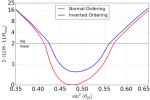As the sun sinks low behind the IceCube Lab, the building’s shadow grows long—it’s almost reaching the South Pole Telescope, as shown here. […]
News
Week 9 at the Pole
The sun is getting lower and lower, and the folks at the South Pole station continue to get everything ready for winter. The winds were strong last week, on some days making it hard to distinguish ground from sky. […]
The Multimessenger Diversity Network: astrophysics joins efforts to broaden participation in STEM
This past weekend, the first members of the new Multimessenger Diversity Network (MDN) met at the University of Wisconsin–Madison, hosted by the Wisconsin IceCube Particle Astrophysics Center. The MDN foundational members are LIGO, VERITAS, and LSST observatories together with IceCube. […]
Week 8 at the Pole
The sun is still out at the South Pole, but it’s getting low in the sky (they have one loooong sunset down there). And it’s cold as usual—a quick run around the block leaves one looking a little frosty. […]
Week 7 at the Pole
Last week, with the IceCube detector behaving well, winterovers Benjamin and Kathrin had a bit more time for extracurriculars. They enjoyed a live webcast with a classroom in Italy and tried their hand at mastering the unicycle. […]
Week 6 at the Pole
Tradition is strong at the South Pole, and last week was validation of that. After the final plane departed with the remaining summer personnel, the winterovering station crew all gathered in the gym for the traditional screening of all three versions of “The Thing.” They engage in this marathon viewing each year. […]
An important step towards understanding neutrino masses
In a new paper by the IceCube Collaboration, physicists use the inner and denser DeepCore detector within IceCube to try to answer this question. A weak preference is shown for NO, a result that is complementary to and in agreement with results from other experiments. This paper has been submitted to the European Physical Journal. […]
Improving searches for galactic sources of high-energy neutrinos
In a recent paper by the IceCube Collaboration, two new techniques have improved searches at energies from 100 TeV down to 100 GeV. When tested with a few years of IceCube data, these new selections improve the sensitivity and discovery potential, for the first time allowing the search for galactic point-like sources using track events created by muon neutrinos, which in many cases are indistinguishable from atmospheric muon tracks. These results have just been submitted to the journal Astroparticle Physics . […]
Week 5 at the Pole
Time flies, even at the South Pole. The winterover staff are getting ready for the pending station close—here IceCube winterover Kathrin is parking one of the last Hercs to have landed for awhile. […]
Week 4 at the Pole
IceCube winterovers Benjamin and Kathrin are showing off a thermometer reading from last week, when temperatures in Madison, WI, and many other midwestern areas were colder than at the Pole. […]









